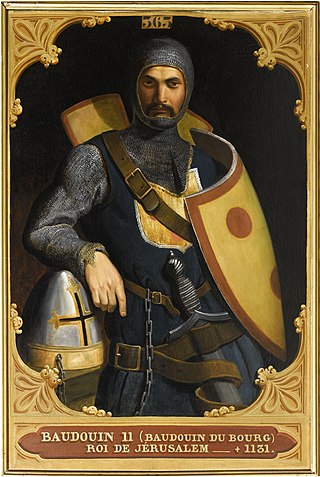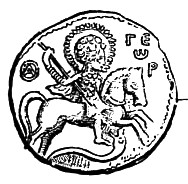The 1110s was a decade of the Julian Calendar which began on January 1, 1110, and ended on December 31, 1119.

Year 1119 (MCXIX) was a common year starting on Wednesday of the Julian calendar.

Bohemond II was Prince of Taranto from 1111 to 1128 and Prince of Antioch from 1111/1119 to 1130. He was the son of Bohemond I, who in 1108 was forced to submit to the authority of the Byzantine Empire in the Treaty of Devol. Three years later, the infant Bohemond inherited the Principality of Taranto under the guardianship of his mother, Constance of France. The Principality of Antioch was administered by his father's nephew, Tancred, until 1111. Tancred's cousin, Roger of Salerno, managed the principality from 1111 to 1119. After Roger died in the Battle of the Field of Blood, Baldwin II of Jerusalem took over the administration of Antioch. However, he did acknowledge Bohemond's right to personally rule the principality upon reaching the age of majority.

Baldwin II, also known as Baldwin of Bourcq or Bourg, was Count of Edessa from 1100 to 1118, and King of Jerusalem from 1118 until his death. He accompanied his cousins Godfrey of Bouillon and Baldwin of Boulogne to the Holy Land during the First Crusade. He succeeded Baldwin of Boulogne as the second count of Edessa when he left the county for Jerusalem following his brother's death. He was captured at the Battle of Harran in 1104. He was held first by Sökmen of Mardin, then by Jikirmish of Mosul, and finally by Jawali Saqawa. During his captivity, Tancred, the Crusader ruler of the Principality of Antioch, and Tancred's cousin, Richard of Salerno, governed Edessa as Baldwin's regents.

The Principality of Antioch was one of the Crusader states created during the First Crusade which included parts of modern-day Turkey and Syria. The principality was much smaller than the County of Edessa or the Kingdom of Jerusalem. It extended around the northeastern edge of the Mediterranean, bordering the County of Tripoli to the south, Edessa to the east, and the Byzantine Empire or the Kingdom of Armenia to the northwest, depending on the date.

In the Battle of Ager Sanguinis, also known as the Battle of the Field of Blood, the Battle of Sarmada, or the Battle of Balat, Roger of Salerno's Crusader army of the Principality of Antioch was annihilated by the army of Ilghazi of Mardin, the Artuqid ruler of Aleppo on 28 June 1119.
Joscelin I was a Frankish nobleman of the House of Courtenay who ruled as the lord of Turbessel, prince of Galilee (1112–1119) and count of Edessa (1118–1131). The County of Edessa reached its zenith during his rule. Captured twice, Joscelin continued to expand his county, even participating in the Battle of Azaz in 1125. Gravely injured during the collapse of a sapper mine, Joscelin marched his army to relieve the besieged fortress of Kaysun, and died soon after.

Pons was count of Tripoli from 1112 to 1137. He was a minor when his father, Bertrand, died in 1112. He swore fealty to the Byzantine Emperor Alexios I Komnenos in the presence of a Byzantine embassy. His advisors sent him to Antioch to be educated in the court of Tancred of Antioch, ending the hostilities between the two crusader states. Tancred granted four important fortresses to Pons in the Principality of Antioch. Since Pons held his inherited lands in fief of the kings of Jerusalem, Tancred's grant strengthened the autonomy of the County of Tripoli. On his deathbed, Tancred also arranged the marriage of his wife, Cecile of France, to Pons.
Constance of Hauteville (1128–1163) was the ruling princess of Antioch from 1130 to 1163. She was the only child of Bohemond II of Antioch and Alice of Jerusalem. Constance succeeded her father at the age of two after he fell in battle, although his cousin Roger II of Sicily laid claim to Antioch. Alice assumed the regency, but the Antiochene noblemen replaced her with her father, Baldwin II of Jerusalem. After he died in 1131, Alice again tried to take control of the government, but the Antiochene barons acknowledged the right of her brother-in-law Fulk of Anjou to rule as regent for Constance.
Najm ad-Din Ilghazi ibn Artuq was the Turkoman Artukid ruler of Mardin from 1107 to 1122. He was born into the Oghuz tribe of Döğer.

The principality of Galilee was one of the four major seigneuries of the crusader Kingdom of Jerusalem, according to 13th-century commentator John of Ibelin, grandson of Balian. The direct holdings of the principality centred around Tiberias, in Galilee proper, but with all its vassals, the lordship covered all Galilee and southern Phoenicia. The independent Lordship of Sidon was located between Galilee's holdings. The principality also had its own vassals: the Lordships of Beirut, Nazareth, and Haifa.

The Battle of Sarmin, also known as the Battle of Tell Danith, took place on September 14, 1115 with Roger of Salerno's Crusader army surprising and routing the Seljuk Turkish army of Bursuq ibn Bursuq of Hamadan. It is also known as the First Battle of Tell Danith, distinguishing it from the Battle of Hab of 1119, the Second Battle of Tell Danith.

The Battle of Hab, also known as the Second Battle of Tell Danith, occurred on August 14, 1119, where a Crusader army commanded by King Baldwin II of Jerusalem won a disputed victory over a Muslim army led by Ilghazi of Mardin since the Muslim army claimed it as a victory also. The battle stabilized the Principality of Antioch, which had suffered a disastrous defeat only weeks before. Baldwin II managed to re-take all of the castles conquered by Ilghazi and prevented him from marching on Antioch.
Zahir al-Din Toghtekin or Tughtekin, also spelled Tughtegin, was a Turkoman military leader, who was emir of Damascus from 1104 to 1128. He was the founder of the Burid dynasty of Damascus.

The timeline of the Principality of Antioch is a chronological list of events of the history of the Principality of Antioch.
Bursuq ibn Bursuq, also known as Bursuk ibn Bursuk, was the emir of Hamadan.
Robert fitz-Fulk the Leper, also known as Robert Fulcoy, Robert the Leprous, or Robert of Saone, was a powerful baron in the Principality of Antioch.
Rainald I Masoir, also known as Renaud I Masoir, was constable of the Principality of Antioch from around 1126, and also baillif of the principality from 1132. Although he was a prominent military commander and held important offices, most details of his life are unknown. He received his first estates in the southern regions of Antioch in the 1110s. He made the strong fortress of Margat the center of his domains. He regularly witnessed the Antiochene rulers' diplomas from the 1120s. He was most probably still the actual ruler of the principality when he died.
The siege of Aleppo by Baldwin II of Jerusalem and his allies lasted from 6 October 1124 to 25 January 1125. It ended in a Crusader withdrawal following the arrival of a relief force led by Aqsunqur al-Bursuqi.
The Lordship of Marash was a territorial lordship in northeastern Cilicia between 1104 and 1149, centred on the city of Marash. One of the lesser Crusader states, it played a major role in the defence of the northern frontier in the 1130s and 1140s under Lords Geoffrey and Baldwin. Its position became untenable after the fall of Edessa in 1146.










